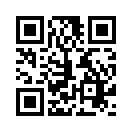[054] Switching of the airway and esophagus (GB#105A04) | 基礎医学教育研究会(KIKKEN)Lab
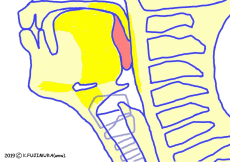
● Understanding swallowing
Personal speed of understanding and learning is used be expressed such as “good” or “bad swallowing” in Japanese. The mechanism of the actual swallowing itself, however, is not likely to be easy to “swallow”. Actually, on the way to this path, a wide passage leading to the lung is open, and it requires a fairly sophisticated trick to pass foods and drinks beyond this.
Contents
- 1 ●swallowing action called 嚥下
- 2 ●Swallowing at least three stages of flow work
- 3 ● Switch the connection between the nose and mouth for the soft palate
- 4 ● The larynx is open in the back of the pharynx, the esophagus is not open
- 5 ● Pharyngeal beginning, flow of hyoid bone and tongue muscle
- 6 ● Late half of pharyngeal phase, epiglottis with protrusions with core
- 7 ● Later in the pharyngeal phase, the larynx is a close-by battle discard
- 8 ● Esophagus is opened by laryngeal movement
- 9 ● Things to eat chewed are gradually sent to the pharynx
- 10 ● Can not swallow and breathe simultaneously
- 11 ● Nasal breathing and mouth breathing
- 12 ● Dog breathing
- 13 ● Dolphins can not breathe in their mouth
- 14 ○ Referenced sites
- 15 ○ Related articles
- 16 ○ Referenced books
●swallowing action called 嚥下
Swallowing is called “嚥下, En-ge” (swallowing / deglutition) in Japanese technical terms. Although it seems that it is not a mistake when reading on the net as a general term as “EN-KA”, it may not be able to communicate in the medical field. When eating foods, before the swallowing, there is an action called “咀嚼, So-shaku” (chewing / mastication) that chews or grinds.
In “So-shaku” and “En-ge”, it is strange to use a difficult language as a noun in Japanese, even though there is no letter of the verb, “噛む, to chew” or “呑み込む, to swallow” in it. With regard to “喉, No-do” (throat), “咽頭, In-tou” (pharynx) and “喉頭, Ko-tou” (larynx) are coming out. The word “口, Kuchi, mouth” is very simple kanji, but is there any special meaning that kanji that is hard barely rampant around the mouth?
●Swallowing at least three stages of flow work
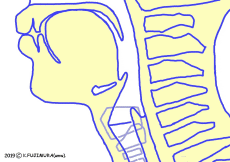
Aside from that, even if you swoop out only, there are at least three steps in its movement. First of all, you need to feed what you are eating from the mouth (“口腔, Ko-ku”, oral cavity) to the throat entrance, pharynx. Here, the work of the “舌, Ze-tu” (tongue) is important, it is called “Ko-ku stage” (oral stage). It is a voluntary movement that you can start with your own will, which will also be a signal to swallow from now.
The “In-tou phase” (pharyngeal stage) in which the passing food and drink (let’s call it a passing object here) pass through the throat part and finally the throat , descending from the esophagus (esobugus, esophagus) with a peristaltic movement “Shoku-dou phase” (esophageal stage), in order, the passage is sent to the stomach. Pharyngeal phase and esophagus phase proceed in arbitrary order according to the sequence and progress in the medulla oblongata of the brainstem. It is a reflex movement with the center.
● Switch the connection between the nose and mouth for the soft palate
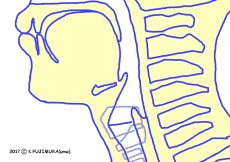
As you open your mouth, you can see a fold hanging uvula. This is a soft palate made of muscle, and the behind it is the pharynx. The pharynx is divided into three parts, upper, middle and lower, saying the wider part from the back of the nasal cavity to the lower part just before the esophagus.
The wall of the throat which opens its mouth and looks deep is the wall of the mesopharynx / oropharynx. In English it seems to be more often called the pharyngeal oral part (oropharynx). The invisible part hidden behind the soft palate is the nasopharynx. At the time of swallowing, the soft palate serves to block the oropharynx and the nasopharynx so that the passing material does not get into the nasopharynx.
● The larynx is open in the back of the pharynx, the esophagus is not open
The tongue visible when opening the mouth is like the tip of the iceberg, the tip of the mass of the large tongue muscle, the root of the tongue extends to the back of the pharynx . From the table there is a small upward facing upward look like the tip of a shoe vera beneath the tongue tonsil (lingual tonsil) at the base of the tongue muscle behind it that requires special equipment. Beyond that, wide cavities are open, but it is not the esophagus but the entrance to the trachea leading to the lungs, the part called the larynx.
The larynx is a rugged tube based on thyroid cartilage and cricoid cartilage (cinnabar ring, cricoid). On top of that is called the epiglottis, which will become the laryngeal lid. This epiglottis to the esophagus hits the hypopharynx. At this time, the entrance of the esophagus that should be lined with the larynx can not be seen anywhere.
In many explanatory figures, the esophagus is an image drawn in the form of a tube, but the esophagus except at that time just swallows things, has collapsed between the cricoid of the larynx and the back spine, and as a tube it is not open.
From the stereoscopic viewpoint, the hypopharynx becomes a shape that the tip of a thick tube called the larynx projects obliquely from the outside on the side of the round bottom of the acupuncture point of the pharynx. The incision of the cylinder is oblique so that the top will come off, and the sharp jump out is the epiglottis.
● Pharyngeal beginning, flow of hyoid bone and tongue muscle
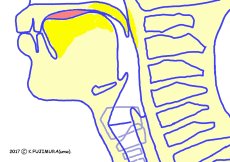 At the end of the oral period of the swallowing exercise, after the passing material reaches the oropharyngeal wall, it is switched to roughly automatic driving afterwards.
At the end of the oral period of the swallowing exercise, after the passing material reaches the oropharyngeal wall, it is switched to roughly automatic driving afterwards.
At the base of the tongue muscle, a small bone called a hyoid bone is buried. Since no bones are making joints, in studying osteology it was as though the impression was thin and forgotten, but besides the tongue muscles, the lower jaw, the throat and the shoulder it is one of the important parts that various streaks from are connected and it is indispensable for swallowing.
At the beginning of the pharyngeal phase, as the hyoid bone is drawn from the fixed position to the front of the jaw, at the same time, the root of the tongue makes a hard aneurysm (hump) and moves downwards so as to follow it, together muscle wall muscles perform peristalsis by control of the medulla oblongata and flow into the oropharynx , sending the thing that has come toward the hypopharynx.
● Late half of pharyngeal phase, epiglottis with protrusions with core
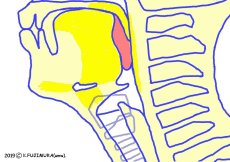
The central part of the epiglottis contains a core made of flat elastic cartilage called epiglottic cartilage. If I have such a positive upside, I am worried that it will become an obstacle when swallowing. However, when swallowing, this epiglottis inverts to the pattern and downwards and plays the role of a shield that prevents the entry of passing objects into the larynx.
The upper half of the oblique incision of the hose is bent and it covers the opening of the incision. When the passing object passes, it returns to the original shape immediately with the pattern again. If there is no core, this will not work.
Depending on the drawing of the textbook, it seems that passing objects push down the epiglottis by themselves, but in fact it is more elaborate and it seems that this is the event that becomes the biggest point of swallowing.
● Later in the pharyngeal phase, the larynx is a close-by battle discard
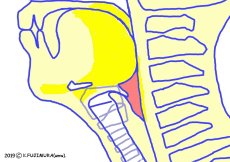
As the passing thing falls down the oropharynx at a stretch, it is serious when entering the trachea, so the larynx must protect the larynx so that it does not get through.
Normally, in such a case, we think that the entrance should close the lid all the time, or if you move the entrance, you may think about a mechanism that keeps the lid apart as if to escape from the approaching one. However, the place where the larynx is daring to pass through things is daring. The thyroid cartilage surrounding the entrance of the larynx and the hyoid bone are connected by a thyrohyoid muscle, and while the hyoid bone moves forward, the thyroid cartilage is pulled up at once to the trachea following it.
How does this relate to swallowing? Actually, the root of the epiglottic cartilage which protruded to the pharynx extends far to the front wall of the thyroid cartilage and the root is fixed like a hinge. In the latter half of pharyngeal phase, the epiglottis is pressed down from the top of the tongue base and at the same time when the thyroid cartilage is lifted, the epiglottis rapidly rotates so that the crown faces downward with the base of the tongue as the fulcrum. It is supposed to be swallowing from the top to the bottom, but “Midgette” rise nostalgically, it was such a trick in the back.
If the switching delayed even for a moment, there is a danger of sucking in the passing object, but it is probably a way of discarding to save as much time as possible for closing the lid. And unfortunately, it is also a weak point that sometimes it will fail if you get old.
● Esophagus is opened by laryngeal movement
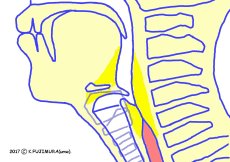
In the latter half of the pharyngeal phase, toward the anterior hyoid bone, the larynx is pulled out forward as it lifts. Then the entrance of the esophagus, which had been crushed behind the larynx, was pulled and spread out. When the passing object is guided around the lidded larynx to enter the entrance of the esophagus, it will be pressed toward the stomach by peristalsis of the automatic movement of the esophagus.
When passing through the esophagus, the esophagus is hard to spread in the part of the robust cricoid cartilage, but after passing it it is only the smooth muscle wall behind the trachea along the esophagus, the esophagus conveys the passing material while comfortably bulging.
By the way, the pharyngeal muscle is a striated muscle, and the esophagus is not a smooth muscle around the larynx but it is made of striated muscle. So it is a reflex movement by control of the medulla oblonga, even though it is automatic exercise, as it gets closer to the stomach it changes to smooth muscle and from the lower third of the esophagus it becomes only smooth muscle just like the digestive tract beneath it. Really, I am impressed that it works well.
● Things to eat chewed are gradually sent to the pharynx
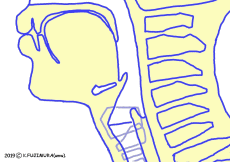 The above setup is basically the flow when swallowing things at once, When swallowing while eating like rice, it seems that they are taking a way to swallow at a stroke where they accumulate to a certain extent while sending them to the oropharynx little by little. Where to store it, the larynx is a tube that jumped out to the key point called the pharynx so that you can afford to some extent the part that hits the bottom of the cylinder around the cylinder.
The above setup is basically the flow when swallowing things at once, When swallowing while eating like rice, it seems that they are taking a way to swallow at a stroke where they accumulate to a certain extent while sending them to the oropharynx little by little. Where to store it, the larynx is a tube that jumped out to the key point called the pharynx so that you can afford to some extent the part that hits the bottom of the cylinder around the cylinder.
In particular, there is a deep depression as the name of epiglottic vallecula between epiglottic spatula and tongue base, and the mouth of the esophagus is not opened, but both of the tube of that part. The side is a pear shaped depression (piriform sinus), which is a baglike structure, and usually it is supposed to swallow saliva after accumulating to a certain extent. When chewing is accompanied, it seems that the reflection is temporarily suppressed so that a swallowing movement does not occur automatically even if solid passing substance touches the oropharynx.
● Can not swallow and breathe simultaneously
As apparent from the complicated mechanism as described above, breathing is blocked because air can not enter and exit the pharynx during swallowing. In the middle of the larynx, there is a fold called vocal cords used when giving a voice, which closes tightly during swallowing and also plays a role of a shutter that does not pass passing objects by mistake.
In addition, control of the central nervous system, breathing exercise is temporarily suppressed in swallowing. Try swallowing while sounding the vocal cords. you find it impossible to keep on telling your voice no matter how hard you try.
Also, swallowing is easy while exhaling, but it is a little difficult while breathing in. It would be a worry to reduce the risk of accidental inhalation. It is easy to fail to swallow while sucking in. Since it works only in this complicated system, it is also unlikely that if something wrong happens, especially if you fail to control nerves it will cause aspiration.
● Nasal breathing and mouth breathing
Even when opening the mouth and looking at the back of the throat, the soft palate is raised to what mind and is blocking the nasopharynx. Even if you breathe like this, air should not come in and go out of your nose, as you can see by touching the hole in the nose.
Conversely, if you try to breathe in your nose with this nose, the soft palate will immediately descend and at the same time the tongue base will also be lifted, blocking the entrance and exit of the air from the mouth to the pharynx. When trying to open the entrance and try to lower the tongue base, the soft palate also lifts and this time the entry and exit of air from the nose is blocked. Apparently, it is not allowed to have both nasal breathing and mouth breathing at the same time.
● Dog breathing
Dogs have rumors that they can not breathe mouth. Unlike humans, because the soft palate is extending to the epiglottis (which is certain), the path of air through the nose and the path of food through the oral cavity are almost separated. It certainly seems that it is also possible to drink water while breathing in his nose. Then, what is the dog doing ha ha? That dog does not sweat, so it is said that he is doing it for divergence of body heat instead.
That’s right. However, is not the air coming in and going out of the respiratory tract, is it stopped only by the oral cavity and pharynx? I can only see the lungs moving together, and if that is not breathing, is breathing done separately from the nose? Breathing deeply with their nose while ha-ha with mouth, it feels like a tricky difficulty. First, when they bark, it seems that thy are calling out from their mouth using the vocal cords. Of course, at that time it is certain that the mouth and the airway are connected, so it is strange that they can not breathe in their mouth. I can not find clear answers on the net. I would like the veterinarian to properly explain it.
● Dolphins can not breathe in their mouth
On the other hand, dolphins and whales know that they can not breathe in the mouth due to their structure. The larynx cylinder extends long and passes through the pharynx into the nasal cavity because it fits snugly into the body, air can enter and exit exclusively through the nostrils.
It is well known that the mysterious hole that opens at the top of the dolphin head is a dolphin’s nose hole. It is functional because breathing can be done just by putting out the forehead on the sea surface, but there are few people who are conscious of being too conscious of being overwhelmed when closing that. In fact, there are also examples of poor whales that fish caught in the back of the nasal cavity and suffocated.
The reason why the fish is clogged is that the laryngeal cylinder is not integrated into the nasal cavity, so it seems that the fish swallowed from the mouth as a prey entered into the gap. If the mouth and the airway are separated, it is functional as it is not necessary to stop breathing while eating, but there are unexpected weak points.
Speaking of another weak point, when the mouth and breathing are separated, I think that they can not feel the flavor of things put in their mouth. We sometimes find dolphins that have swallowed plastic bags I guess that might be the reason . Even if it is not a dolphin, mammals other than humans, including dogs, tend to be able to drink and eat while breathing, so it may be the same that the flavor is hard to understand.
Instead, in most animals the nostrils and mouth are in close proximity, sniffing before eating. Dolphins may have sacrificed important things because they separated their nose and mouth.
Humans feel the flavor of various foods thanks to the crossover of the mouth and the respiratory tract, and I feel fortunate that I can live even if my nose is clogged.
○ Referenced sites
・咽頭の臨床解剖, 吉原俊雄 著, 2008.
・嚥下機能にまつわる昨今の生理学的知見, 井上 誠, 2012.
・CGにより嚥下を見る,(特定非営利活動法人 嚥友会)
・プロセスモデルで考える咀嚼嚥下リハビリテーション, 松尾 浩一郎, 2015.
・嚥下アニメーション「咽頭の解剖生理 / 咀嚼嚥下の一例 (内視鏡検査視線)」-舌根-咽頭後壁間の接触を透明化-
・嚥下機能の学習, by JA北海道常呂厚生病院
・Scientists Discover a Mouth-Breathing Dolphin, 2016.
・イルカが食べたごみ;NHK for School
○ Related articles
◆[046] Digestion and metabolism ![]()
◆[022] 胃と十二指腸 the stomach and the duodenum ![]()
◆[009] 筋収縮の伸縮幅 the range of muscular contraction ![]()
◆[035] 骨格筋収縮の張力 tension of the skeletal muscle contraction ![]()
◆[005] Peristalsis ![]()
◆[012] 分節運動 intestinal segmentation ![]()
◆[033] 平滑筋の収縮 smooth muscle contraction ![]()
◆[003] Diaphragmatic breathing ![]()
◆[015] 胸式呼吸 costal breathing ![]()
◆[010] 肺胞換気量と死腔 alveolar ventilation and dead space ![]()
◆[049] A neural circuit for voluntary movement ![]()
◆[044] 伸張反射 stretch reflex ![]()
○ Referenced books
・カラー図解 人体の正常構造と機能 全10巻縮刷版,坂井 建雄,日本医事新報社
・人体機能生理学,杉 晴夫,南江堂
・柔道整復学校協会編「生理学」,南江堂
・東洋療法学校協会編「生理学」,医歯薬出版株式会社
rev.20170902, rev.20170909, rev.20170929, rev.20180103, rev.20180211, rev.20190929.
KISO-IGAKU-KYOIKU-KENKYUKAI(KIKKEN)








